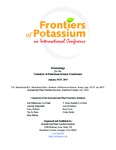Please use this identifier to cite or link to this item:
http://www.alice.cnptia.embrapa.br/alice/handle/doc/1069571| Title: | Silt as K source for crops in tropical soils. |
| Authors: | VOLF, M.  BENITES, V. de M.   ROSOLEM, A. C.   CRUSCIOL, A. C.   MORAES, F. M.   MENEZES, F. J.   SILVA, C. A.   |
| Affiliation: | MARCELO RAPHAEL VOLF, UNESP; VINICIUS DE MELO BENITES, CNPS; CIRO ANTONIO ROSOLEM, UNESP; CARLOS ALEXANDRE COSTA CRUSCIOL, UNESP; MILTON F. MORAES, UFMT; JUNE FARIA SCHERRER MENEZES, UNIRV; ANA C. SILVA, DALCIN LABORATORY OF SOIL AND PLANT. |
| Date Issued: | 2017 |
| Citation: | In: FRONTIERS OF POTASSIUM SCIENCE CONFERENCE, 2017, Rome. Proceedings... Peachtree Corners: International Plant Nutrition Institute, 2017. Ref. P185-P193. |
| Description: | The original soil exchangeable potassium (K) concentrations are at or above critical levels in many Brazilian Cerrado (savanna) soils. Hence, many cropped areas have been fertilized with low K rates, below crop requirements, but yields have not decreased as expected. In these areas, topsoil exchangeable K analyses have shown no decrease, or even some increase. The aim of this study was to evaluate exchangeable and non-exchangeable K forms in soils under different uses and managements in the Vale do Araguaia region of Mato Grosso state, Brazil. Soil samples were taken from 91 sites at depths of 0-20 cm and 20-40 cm, in areas under grain crops, pasture and native vegetation (Cerrado or forest). Silt content ranged from 12 to 175 g kg-1 and clay from 90 to 595 g kg-1, and the predominant clays were kaolinite, hematite, goethite and gibbsite. Under pasture, the soils had high levels of exchangeable K in the 0-20 cm layer and high levels of non-exchangeable K from 20 to 40 cm. This can be a result of the absorption of non-exchangeable K by grasses, the main cultivated species, by recycling K to the exchangeable fraction in the topsoil. There was a positive relationship between silt and non-exchangeable K contents. Ratios of exchangeable to non-exchangeable K were over 3 in soils with silt above 70 g kg-1, in which non-exchangeable K was over 100 mg dm-3. Cover crops growing in soils rich in silt take up non-exchangeable K and exchangeable K from deeper layers, which is recycled to the soil as exchangeable K upon plant residue mineralization, which may have been responsible for the maintenance or increase in exchangeable K levels in the 0-20 cm layer in areas where low K rates have been used for grain production. |
| Thesagro: | Solo Cerrado |
| Keywords: | Vale do Araguaia |
| Type of Material: | Artigo em anais e proceedings |
| Access: | openAccess |
| Appears in Collections: | Artigo em anais de congresso (CNPS)  |
Files in This Item:
| File | Description | Size | Format | |
|---|---|---|---|---|
| 2017004.pdf | 276.93 kB | Adobe PDF |  View/Open |









